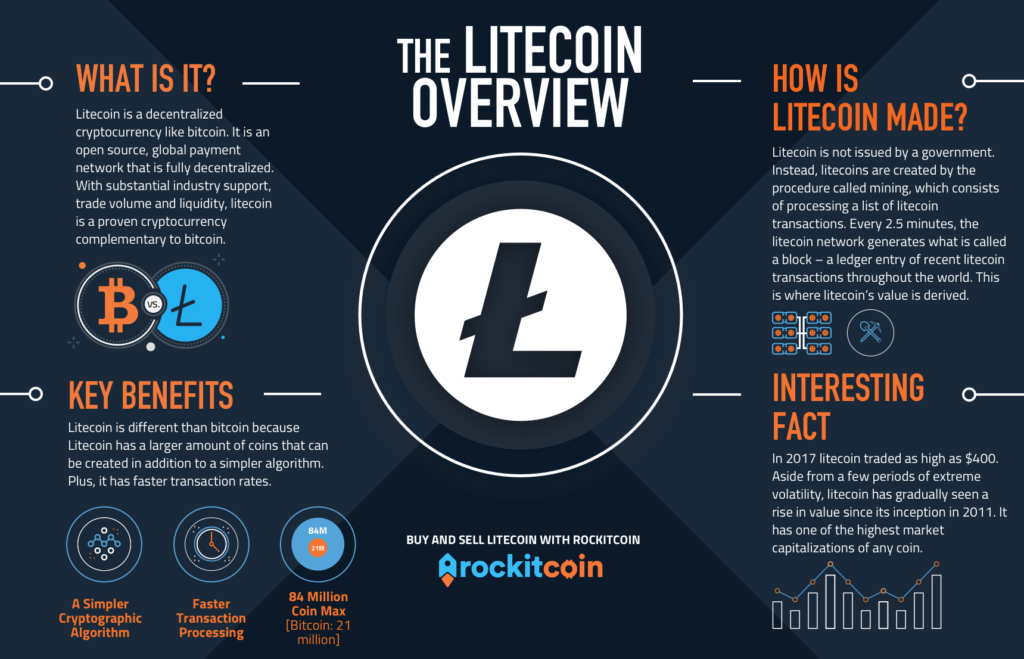What Is Litecoin? A Comprehensive Guide by RockItCoin
Cryptocurrencies have revolutionized the way we think about money. In the vast world of digital currencies, one name that consistently stands out is Litecoin. But what exactly is Litecoin? Let’s delve deep into understanding this fascinating digital asset.

What is Litecoin?
Litecoin is a decentralized digital currency, or cryptocurrency, that operates on a peer-to-peer network. This means that it functions without a central authority or single administrator. Every transaction is recorded on a decentralized ledger called the blockchain, which is accessible to anyone and is maintained by a network of computers (or “nodes”). Litecoin offers a way to transact globally without the need for traditional financial institutions, and its main appeal lies in its speed, security, and the decentralized nature of its operations.
Now that we have a fundamental understanding let’s dive deeper into its origins and how it stands out in the cryptocurrency world.
Blockchain Technology in Litecoin
When it comes to understanding Litecoin at a more intricate level, it’s essential to grasp its underlying blockchain technology.
- Blocks and Transactions: The Litecoin blockchain consists of a series of ‘blocks’. Each block contains a record of several transactions. When a transaction is made, it gets verified by nodes on the network and then added to a new block. This new block is then appended to the existing blockchain, ensuring a permanent, unalterable record of the transaction.
- Decentralization: Unlike traditional centralized systems where a single entity has control, the Litecoin network is decentralized. This means no single entity, be it a government or financial institution, controls the network. Instead, multiple nodes (computers) participate in the network, ensuring its security and integrity. Decentralization reduces the risk of censorship, fraud, and single points of failure.
A Brief History of Litecoin
Litecoin, often referred to as “the silver to Bitcoin’s gold,” was created in 2011 by former Google engineer, Charlie Lee. It’s an open-source, peer-to-peer digital currency based on the same fundamental principles as Bitcoin but with some variations.
Litecoin’s Unique Features
Litecoin isn’t just another Bitcoin clone; it has features that make it stand distinct in the world of cryptocurrencies:
- Segregated Witness (SegWit) in Litecoin: Introduced as a means to solve Bitcoin’s scalability issues, SegWit is a protocol upgrade that changes the way data is stored. Litecoin was among the first cryptocurrencies to adopt SegWit, which helps increase the block size limit and allows for more transactions to be stored in a single block.
- The Lightning Network and Atomic Swaps: The Lightning Network is a second-layer solution built on top of a blockchain, enabling fast, low-cost transactions. In essence, it opens payment channels between users, allowing them to transact without recording every detail on the blockchain. Litecoin’s compatibility with the Lightning Network also paves the way for atomic swaps, which lets users directly exchange different cryptocurrencies without using a third-party intermediary.
How Does Litecoin Differ from Bitcoin?
- Faster Transaction Times: One of the main differences is the speed of transactions. While Bitcoin transactions might take around 10 minutes to be confirmed, Litecoin transactions are often confirmed in just 2.5 minutes.
- Higher Supply Limit: Bitcoin’s supply is capped at 21 million coins. Litecoin, on the other hand, has a maximum supply of 84 million coins.
- Different Hashing Algorithm: While Bitcoin uses the SHA-256 hashing algorithm, Litecoin utilizes Scrypt. This difference makes Litecoin mining more accessible to individual users, although it’s important to note that specialized mining hardware has also evolved for Litecoin.
Using Litecoin
Like other cryptocurrencies, Litecoin can be used for various online transactions—whether it’s buying goods, services, or transferring funds. Due to its faster transaction times, it’s gaining popularity for merchants and users looking for quick transaction confirmations.
Storing Litecoin: RockItCoin Wallet and Beyond
For those diving into the world of crypto, securing your investment is paramount. Cryptocurrencies are stored in ‘wallets’. There are various types of wallets, including:
- Online Wallets: These are web-based and can be accessed from anywhere. They’re convenient, but can be vulnerable to hacks.
- Mobile Wallets: These are apps on your phone. They’re portable and often user-friendly.
- Desktop Wallets: These are downloaded and installed on a single computer. They provide a good balance between convenience and security.
- Hardware Wallets: These are physical devices that store your cryptocurrency offline. They’re considered the most secure option for large amounts.
- Paper Wallets: These are physical documents that contain your public and private keys.
RockItCoin proudly introduces the RockItCoin Wallet—a secure and user-friendly wallet solution for all your crypto needs. It combines the convenience of online and mobile wallets with robust security features to ensure your assets are safe and accessible.
Buying and Selling Litecoin with RockItCoin
At RockItCoin, we’ve made it easier than ever to step into the world of Litecoin. Whether you’re a newbie or a seasoned crypto enthusiast, our platform offers a straightforward way to buy and sell Litecoin.
- RockItCoin ATMs: Our ATMs are strategically located for your convenience. With an intuitive interface, you can easily purchase Litecoin with cash.
- Online: For those who prefer online transactions, our platform is designed to make the buying and selling process seamless and secure.
Conclusion
Litecoin’s growing popularity and unique features make it a valuable asset in the ever-expanding world of cryptocurrency. Whether you’re looking to invest, transact, or just understand more about it, RockItCoin is here to guide you every step of the way. Dive into the digital age with RockItCoin, and explore the countless possibilities that Litecoin and other cryptocurrencies have to offer.